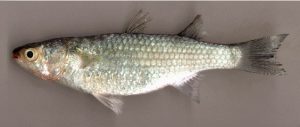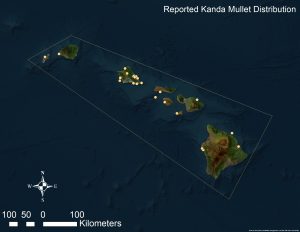Kanda Mullet
Kanda Mullet (Osteomugil engeli)
Description:
- A mullet that is silvery in color, turning slightly dusky dorsally. Has a forked caudal fin with a narrow black margin; the dorsal fins are equally high (Randall 2003)
- Commonly mistaken for undersized ‘ama’ama (Mugil cephalus), a native Hawaiian mullet species (Schemmel et al. 2019)
- Adult size ranges from 30 mm to 209 mm (fork length), with females of the species averaging 23 mm larger than the males (Schemmel et al. 2019)
- This species also spawns year-round and has a short life span of 7 months (Schemmel et al. 2019)
- Generalist feeder that eats microalgae (Schemmel et al. 2019)
Habitat:
- As adults, they prefer nearshore marine and estuary waters
- O. engeli ranges across the Indo-Pacific, reaching from East Africa to the Marquesan and Tuamoto islands to the Yaeyamas (Froese and Pauly 2018)
Impacts & Concern:
- The advantages of year-round spawning and young size at maturity contribute to its success as an invasive species in Hawaiʻi, especially when compared to the native ʻamaʻama, which spawns seasonally and takes 3-4 years to reach sexual maturity (Schemmel et al. 2019)
- Because of their similarity to ʻamaʻama, and small size, many fishermen misidentify the species as undersized ʻamaʻama and release their catch back into the water (Schemmel et al. 2019)
- Dominant species in Hawaiʻi’s estuary ecosystems; it even comprised up to 80% of all mullet populations in Kauaʻi during the 1970s (Schemmel et al. 2019)
- The kanda mullet and ʻamaʻama share habitat space, even as juveniles, and prefer estuaries with invasive mangroves (Goecke and Carstenn 2017)
Introduction:
- Accidentally released in Hawaiʻi (Randall 1987)
- Individuals were present in a bait fish (Marquesan sardine Sardinella marquesensis) population that was purposefully introduced in the 1950s (Randall 1987)
Distribution in Hawaiʻi:
Established throughout the main Hawaiian Islands (Maciolek 1984, Mundy 2005)
- Kauai: Present in marine waters (Maciolek 1984, Mundy 2005)
- Oʻahu: Maunalua Bay (Schemmel et al. 2019), Kāne‘ohe Bay (Parenti et al. 2020)
- Molokai: Present in marine waters (Maciolek 1984, Mundy 2005)
- Lanai: Present in marine waters (Maciolek 1984, Mundy 2005)
- Maui: Present in marine waters (Maciolek 1984, Mundy 2005)
- Big Island: Hilo Bay (Schemmel et al. 2019)
Related AIS Team Management Projects:
- DAR teams have focused on outreach, creating identification cards to teach fishermen and community members how to distinguish between the kanda mullet and native ʻamaʻama and uouoa
- The DAR estuarine team has conducted statewide surveys to try and determine the effects interspecific competition has had between the kanda mullet and ‘ama’ama, as well as learn more about the kanda mullet’s life history traits
News:
Regulations:
- Prohibited for import, not currently listed under HDOA import rules (§4-71-6.5)
References:
- Froese, R., and Pauly, D. (Editors) (2018) FishBase. World Wide Web electronic publication. www.fishbase.org. Accessed August 27 2024
- Goecke, S. D., and Carstenn, S. M. (2017). Fish communities and juvenile habitat associated with non-native Rhizophora mangle L. in Hawai‘i. Hydrobiologia, 803(1), 209–224. https://doi.org/10.1007/s10750-017-3182-7
- Maciolek, J.A. 1984. Exotic fishes in Hawaii and other islands of Oceania. Pages 131-161 in Courtenay, W.R., Jr., and J.R. Stauffer, Jr, eds. Distribution, ecology, and management of exotic fishes. John Hopkins University Press. Baltimore, MD.
- Mundy, B.C. 2005. Checklist of Fishes of the Hawaiian Archipelago: volume 6 Bishop Museum Bulletins in Zoology, Bishop Museum Press, Honolulu, Hawaii, USA.
- Parenti, L.R., D.E. Pitassy, Z. Jaafar, K. Vinnikov, N.E. Redmond, and K.S. Cole. 2020. Fishes collected during the 2017 MarineGEO assessment of Kāne‘ohe Bay, O‘ahu, Hawai‘i. Journal of the Marine Biological Association of the United Kingdom 100(4):607-637. https://doi.org/10.1017/S0025315420000417.
- Randall JE (1987) Introductions of marine fishes to the Hawaiian islands. B Mar Sci 41(2):490–502
- Randall, J.E. 2003. Reef and shore fishes of the South Pacific: New Caledonia to Tahiti and the Pitcairn Islands. University of Hawaii Press, Honolulu, Hawaii, USA.
- Schemmel, E., Kamikawa, K., Shimoda, T., & Peyton, K. A. (2019). The life history of the invasive mullet, Osteomugil engeli (Bleeker, 1858) in Hawaiian estuaries. Environmental Biology of Fishes, 102(4), 553–568. https://doi.org/10.1007/s10641-019-00853-y

